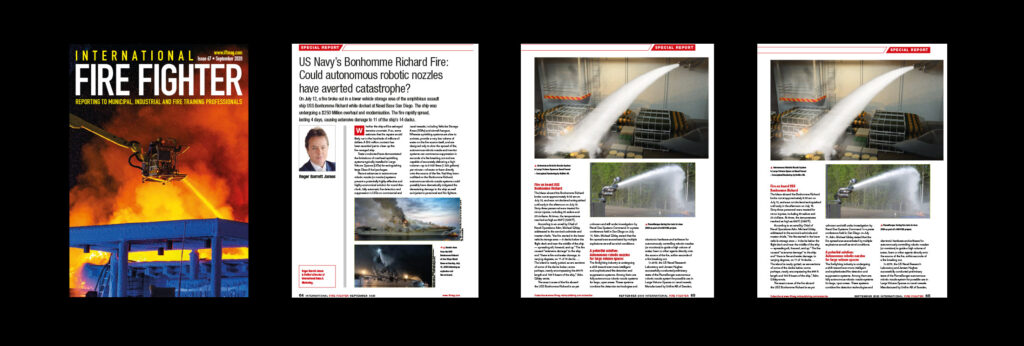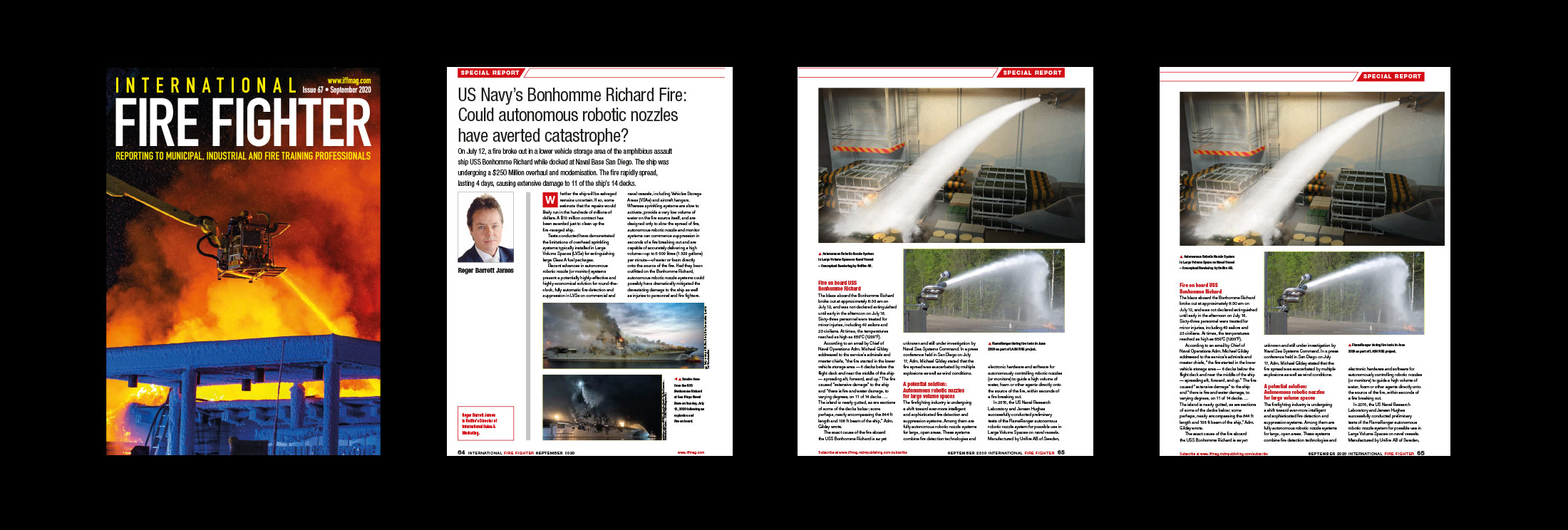The September 2020 issue of International Fire Fighter Magazine has featured an article written by Roger Barrett James of Unifire AB of Sweden discussing whether autonomous robotic nozzles and fire monitors may have mitigated the catastrophic fire on board the USS Bonhomme Richard.
Below is the text of the article, which can also be viewed online on International Fire Fighter’s website by pressing the button below.

US NAVY’S BONHOMME RICHARD FIRE: COULD AUTONOMOUS ROBOTIC NOZZLES HAVE AVERTED CATASTROPHE?
INTRO
On July 12, a fire broke out in a lower vehicle storage area of the amphibious assault ship USS Bonhomme Richard while docked at Naval Base San Diego. The ship was undergoing a $250 Million overhaul and modernisation. The fire rapidly spread, lasting 4 days, causing extensive damage to 11 of the ship’s 14 decks.
Whether the ship will be salvaged remains uncertain. If so, some estimate that the repairs would likely run in the hundreds of millions of dollars. A $10 million contract has been awarded just to clean up the fire-ravaged ship.
Tests conducted have demonstrated the limitations of overhead sprinkling systems typically installed in Large Volume Spaces (LVSs) for extinguishing large Class A fuel packages.
Recent advances in autonomous robotic nozzle (or monitor) systems present a potentially highly-effective and highly-economical solution for round-the-clock, fully automatic fire detection and suppression in LVSs on commercial and naval vessels, including Vehicles Storage Areas (VSAs) and aircraft hangars. Whereas sprinkling systems are slow to activate, provide a very low volume of water on the fire source itself, and are designed only to slow the spread of fire, autonomous robotic nozzle and monitor systems can commence suppression in seconds of a fire breaking out and are capable of accurately delivering a high volume—up to 5 000 litres (1 320 gallons) per minute—of water or foam directly onto the source of the fire. Had they been outfitted on the Bonhomme Richard, autonomous robotic nozzle systems could possibly have dramatically mitigated the devastating damage to the ship as well as injuries to personnel and fire fighters.
FIRE ON USS BONHOMME RICHARD
The blaze aboard the Bonhomme Richard broke out at approximately 8:30 am on July 12, and was not declared extinguished until early in the afternoon on July 16. Sixty-three personnel were treated for minor injuries, including 40 sailors and 23 civilians. At times, the temperatures reached as high as 650℃ (1 200℉).
According to an email by Chief of Naval Operations Adm. Michael Gilday addressed to the service’s admirals and master chiefs, “the fire started in the lower vehicle storage area — 6 decks below the flight deck and near the middle of the ship — spreading aft, forward, and up.” The fire caused “extensive damage” to the ship and “there is fire and water damage, to varying degrees, on 11 of 14 decks. … The island is nearly gutted, as are sections of some of the decks below; some perhaps, nearly encompassing the 844 ft length and 106 ft beam of the ship,” Adm. Gilday wrote.
The exact cause of the fire aboard the USS Bonhomme Richard is as yet unknown and still under investigation by Naval Sea Systems Command. In a press conference held in San Diego on July 17, Adm. Michael Gilday stated that the fire spread was exacerbated by multiple explosions as well as wind conditions.
A POTENTIAL SOLUTION: AUTONOMOUS ROBOTIC NOZZLES FOR LARGE VOLUME SPACES
The firefighting industry is undergoing a shift toward ever-more intelligent and sophisticated fire detection and suppression systems. Among them are fully autonomous robotic nozzle systems for large, open areas. These systems combine fire detection technologies and electronic hardware and software for autonomously controlling robotic nozzles (or monitors) to guide a high volume of water, foam or other agents directly onto the source of the fire, within seconds of a fire breaking out.
In 2015, the US Naval Research Laboratory and Jensen Hughes successfully conducted preliminary tests of the FlameRanger autonomous robotic nozzle system for possible use in Large Volume Spaces on naval vessels. Manufactured by Unifire AB of Sweden, FlameRanger is comprised of two IR array flame detectors, advanced electronic hardware and software, and high-volume robotic nozzles (also known as “water cannons” or “firefighting monitors”). The flame detectors independently detect flames within seconds and determine, and track in real time, the fire’s two-dimensional position. By combining the fire position data from independent detectors placed at juxtaposed angles, the system’s electronics and software are able to triangulate the three-dimensional size and position of the fire. This information is processed by the system to dynamically guide the robotic nozzle to deliver a large volume of water or foam directly onto the fire—all within seconds of the fire breaking out. The system can detect and track multiple fires simultaneously. When fire is no longer detected, the system shuts off the valve, but remains ready to respond again should a new fire break out.
The tests confirmed FlameRanger’s ability to detect all test fires within seconds and accurately aim and suppress them. Tests also proved the system’s ability to detect multiple simultaneous fires and suppress them in the order in which they were detected.
In one of the tests, in which the automatic function was pitted against a human, the automatic function extinguished the test fire faster and with less water than a human fighting the same size fire using a joystick to operate the same robotic nozzle. According to the Naval Research Laboratory’s test report, in one of the tests, the system “detected the fire so quickly, that the firefighting party igniting the heptane pan fires below the stacks of pallets, had to run out of the hangar after ignition. The system applied water to the fuel package within 5 seconds of ignition.”
In addition to the fully automatic response, the FlameRanger’s robotic nozzle can be remotely controlled by human operators over a secure network connection, from anywhere in the world.
An important feature of the FlameRanger system is its theoretically negligible susceptibility to false alarms. This results from the system’s design which requires that both flame detectors—each already with a very low susceptibility to false alarms—independently detect the same fire, at the same time, and at the same location before the system will open the valve and commence suppression.
FlameRanger is also currently undergoing evaluation and testing for the protection of weather decks on ro-ro ships under the European Union-funded LASH FIRE research project. Autonomous monitor systems will be included in the definitions and standards of the LASH FIRE project reports and considered by the International Maritime Organization (IMO) for possible inclusion in new regulations and standards for the protection of ro-ro ship weather decks. A video of successful tests of the system conducted in June this year can be viewed in the news section of the project’s website at lashfire.eu/news. The LASH FIRE project has received funding from the EU’s Horizon 2020 research and innovation programme under grant agreement nº 814975.
CONCLUSION
Autonomous systems are becoming increasingly sophisticated, commercially-available and compelling solutions for fire protection in LVSs on naval and commercial vessels, as well as numerous other applications in large open spaces.
Unifire expects the appearance of such autonomous systems to rapidly increase, as the technology is now available on the market, well-proven, extremely cost-effective, and can limit or possibly prevent the kind of catastrophic damages sustained by the USS Bonhomme Richard fire.
Author: Roger Barrett James
Published in: International Fire Fighter Magazine, Issue 67, September 2020, p. 64-66.


